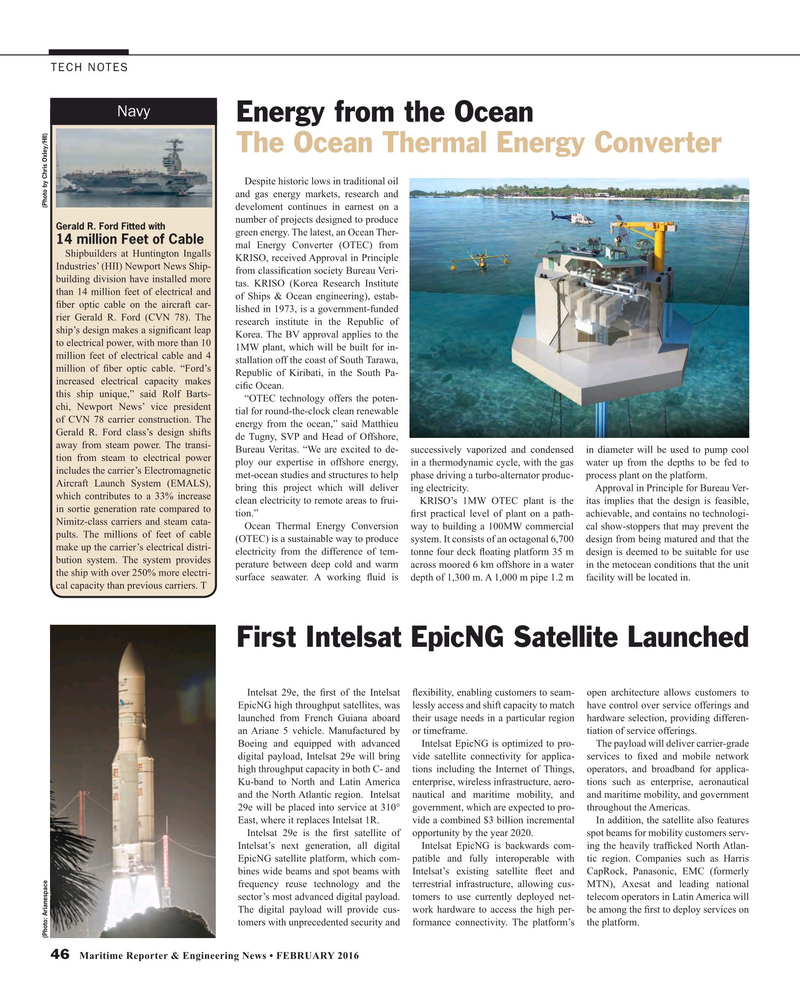
Page 46: of Maritime Reporter Magazine (February 2016)
Cruise Ship Technology Edition
Read this page in Pdf, Flash or Html5 edition of February 2016 Maritime Reporter Magazine
TECH NOTES
Navy
Energy from the Ocean
The Ocean Thermal Energy Converter
Despite historic lows in traditional oil and gas energy markets, research and develoment continues in earnest on a number of projects designed to produce
Gerald R. Ford Fitted with green energy. The latest, an Ocean Ther- 14 million Feet of Cable mal Energy Converter (OTEC) from
Shipbuilders at Huntington Ingalls
KRISO, received Approval in Principle
Industries’ (HII) Newport News Ship- from classi? cation society Bureau Veri- building division have installed more tas. KRISO (Korea Research Institute than 14 million feet of electrical and of Ships & Ocean engineering), estab- ? ber optic cable on the aircraft car- lished in 1973, is a government-funded rier Gerald R. Ford (CVN 78). The research institute in the Republic of ship’s design makes a signi? cant leap
Korea. The BV approval applies to the to electrical power, with more than 10 1MW plant, which will be built for in- million feet of electrical cable and 4 stallation off the coast of South Tarawa, million of ? ber optic cable. “Ford’s
Republic of Kiribati, in the South Pa- increased electrical capacity makes ci? c Ocean.
this ship unique,” said Rolf Barts- “OTEC technology offers the poten- chi, Newport News’ vice president tial for round-the-clock clean renewable of CVN 78 carrier construction. The energy from the ocean,” said Matthieu
Gerald R. Ford class’s design shifts de Tugny, SVP and Head of Offshore, away from steam power. The transi-
Bureau Veritas. “We are excited to de- successively vaporized and condensed in diameter will be used to pump cool tion from steam to electrical power ploy our expertise in offshore energy, in a thermodynamic cycle, with the gas water up from the depths to be fed to includes the carrier’s Electromagnetic met-ocean studies and structures to help phase driving a turbo-alternator produc- process plant on the platform.
Aircraft Launch System (EMALS), bring this project which will deliver ing electricity. Approval in Principle for Bureau Ver- which contributes to a 33% increase clean electricity to remote areas to frui- KRISO’s 1MW OTEC plant is the itas implies that the design is feasible, in sortie generation rate compared to tion.” ? rst practical level of plant on a path- achievable, and contains no technologi-
Nimitz-class carriers and steam cata-
Ocean Thermal Energy Conversion way to building a 100MW commercial cal show-stoppers that may prevent the pults. The millions of feet of cable (OTEC) is a sustainable way to produce system. It consists of an octagonal 6,700 design from being matured and that the make up the carrier’s electrical distri- electricity from the difference of tem- tonne four deck ? oating platform 35 m design is deemed to be suitable for use bution system. The system provides perature between deep cold and warm across moored 6 km offshore in a water in the metocean conditions that the unit the ship with over 250% more electri- surface seawater. A working ? uid is depth of 1,300 m. A 1,000 m pipe 1.2 m facility will be located in.
cal capacity than previous carriers. T
First Intelsat EpicNG Satellite Launched
Intelsat 29e, the ? rst of the Intelsat ? exibility, enabling customers to seam- open architecture allows customers to
EpicNG high throughput satellites, was lessly access and shift capacity to match have control over service offerings and launched from French Guiana aboard their usage needs in a particular region hardware selection, providing differen- an Ariane 5 vehicle. Manufactured by or timeframe. tiation of service offerings.
Boeing and equipped with advanced Intelsat EpicNG is optimized to pro- The payload will deliver carrier-grade digital payload, Intelsat 29e will bring vide satellite connectivity for applica- services to ? xed and mobile network high throughput capacity in both C- and tions including the Internet of Things, operators, and broadband for applica-
Ku-band to North and Latin America enterprise, wireless infrastructure, aero- tions such as enterprise, aeronautical and the North Atlantic region. Intelsat nautical and maritime mobility, and and maritime mobility, and government 29e will be placed into service at 310° government, which are expected to pro- throughout the Americas.
East, where it replaces Intelsat 1R. vide a combined $3 billion incremental In addition, the satellite also features
Intelsat 29e is the ? rst satellite of opportunity by the year 2020. spot beams for mobility customers serv-
Intelsat’s next generation, all digital Intelsat EpicNG is backwards com- ing the heavily traf? cked North Atlan-
EpicNG satellite platform, which com- patible and fully interoperable with tic region. Companies such as Harris bines wide beams and spot beams with Intelsat’s existing satellite ? eet and CapRock, Panasonic, EMC (formerly frequency reuse technology and the terrestrial infrastructure, allowing cus- MTN), Axesat and leading national sector’s most advanced digital payload. tomers to use currently deployed net- telecom operators in Latin America will
The digital payload will provide cus- work hardware to access the high per- be among the ? rst to deploy services on tomers with unprecedented security and formance connectivity. The platform’s the platform. (Photo: Arianespace (Photo by Chris Oxley/HII) 46 Maritime Reporter & Engineering News • FEBRUARY 2016
MR #2 (42-49).indd 46 2/3/2016 11:22:15 AM

 45
45

 47
47
